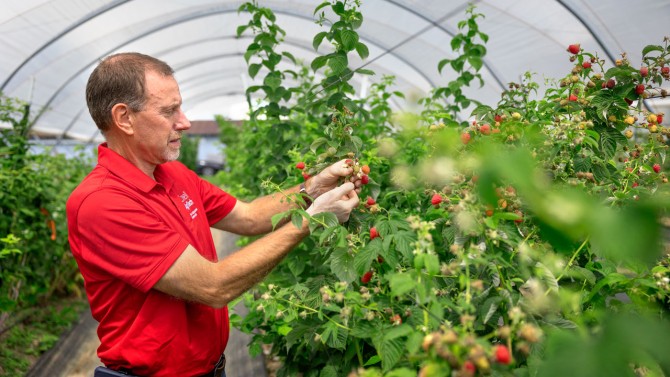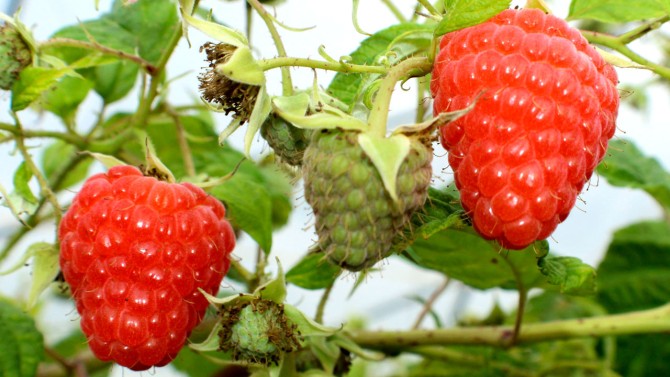The Cornell AgriTech berry breeding program has released two new red raspberry varieties, crimson beauty and crimson blush. These add to three previous Cornell "crimson series" raspberry releases: crimson treasure, crimson giant and crimson night.
"We have tested these with local growers in New York and in other states as well, and we've gotten very positive feedback, so we've decided to move forward with naming and commercializing them," said Courtney Weber, professor and section head in the School of Integrative Plant Science Horticulture Section in the College of Agriculture and Life Sciences, who leads Cornell AgriTech's berry breeding program.
Courtney Weber, professor in Cornell AgriTech's berry breeding program, with Crimson Beauty raspberries.
The seed for the two new varieties was developed in 2016, and plants were first grown and selected for further evaluation in 2017.
Crimson beauty is a large, bright glossy red variety with a strong raspberry flavor that has tropical overtones. While some raspberry varieties fruit in the summer, ending by the end of July, this one bears in the late summer to early fall. In developing crimson beauty, Weber wanted to bridge the gap between late July when the summer raspberries finish harvest and when fall fruiting varieties typically start to ripen in August, for continuous production. "We've been working to close that gap, and this variety does close it," Weber said. "There are summer varieties that overlap harvest with crimson beauty."
Its canes are very upright and open with the cone-shaped fruit held up on the top of the plant, making berries easy to find and pick. Fresh market raspberries are all handpicked, and can be subject to labor shortages, so the architecture of the plant makes picking more efficient.
Crimson beauty was bred for growing in high tunnels, a common practice in the raspberry industry to reduce rain exposure, waste and rotting.
"It's a much more productive system and much more efficient with drip irrigation," Weber said. "Crimson beauty was selected within this system and developed for this system."
Crimson blush, on the other hand, was developed in a more traditional open field system, but can also be grown in tunnels for fall season extension. The flavorful fruit ripens later in the year, from September into November. Its name comes from the color: blush pink to a light, bright red. It produces large, sweet and juicy berries on vigorous canes and is a heavy producer.
"It's a nice treat for the end of the harvest season," Weber said.
Cornell is collaborating with two commercial partners - PhyllaTech, L.L.C., based in North Carolina, and North American Plants, in Oregon - which have licenses to propagate the varieties and will have plants available for commercial growers to order ahead for next spring's planting.
They also have a third partner, Gurney's Seed and Nursery Co., part of the Gardens Alive! company, that will have crimson blush available for the retail market and homeowners.
"I've been at Cornell for over 25 years and the industry has changed tremendously over that time period," Weber said. Raspberries used to be available only locally in season and weren't sold in supermarkets. "Now, consumers expect big, perfect raspberries in the supermarket year round. The whole industry has had to change to make that possible."
The varieties were developed in collaboration with the New York State Berry Grower's Association. The New York State Department of Agriculture and Markets also supports the Cornell AgriTech berry breeding program.









